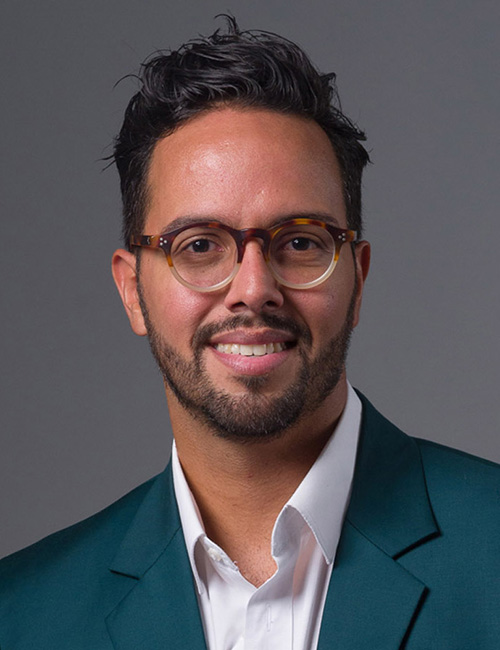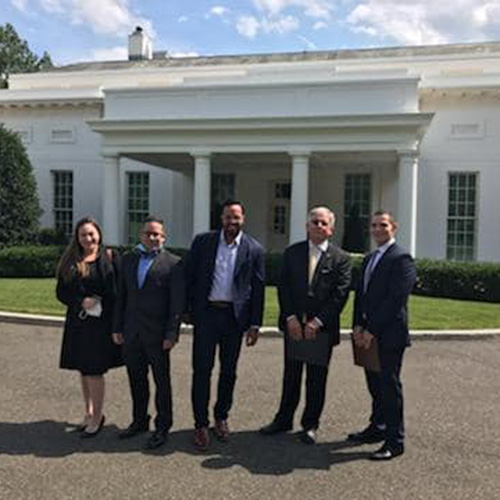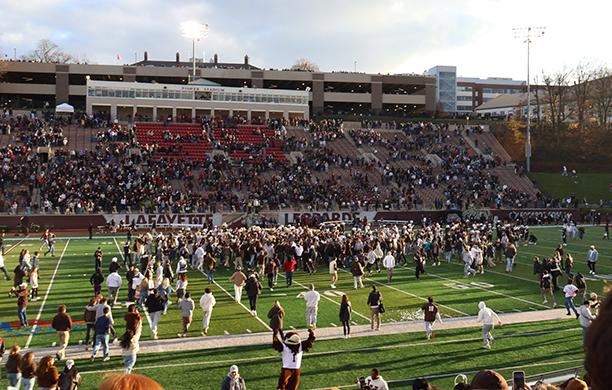
Launched in 2024 as the first university research center at Lehigh, the Center for Catastrophe Modeling and Resilience is an interdisciplinary home for researchers in the academic, business, public, and private sectors who use simulations to estimate the potential losses from catastrophic events.
While the work at this center is galvanizing ways to use data to inform preparations and responses to global catastrophes, Lehigh graduates have been pioneers in this field for years. Meet one leader who is bringing awareness, action, and change to this global opportunity.
Eddie Guerra ’10G
Master’s in Structural Engineering
Background
Growing up on the western side of Puerto Rico, Guerra was surrounded by family, faith, and hard work. His mother owned a small business while his father taught English and served as an Air Force chaplain. He was inspired early by his teachers, loving math as well as engineering. While many boys on the island were immersed in the culture of boxing and baseball, Guerra traveled every weekend to an academy where he studied landscape painting. Art became, and has remained, a creative outlet for him to release stress and stay grounded — a way to step away for a moment from his analytical mind. His heart eventually took him to the civil engineering department at the University of Puerto Rico, where he thrived, earning an invitation to Tau Beta Pi, the international engineering honor society.
Lehigh Days
As an undergraduate, Guerra was strongly encouraged by a professor to apply for a summer research program at Lehigh. Guerra completed the application and was accepted. He spent the summer of 2007 on campus, falling in love with structural engineering, the faculty, and the Advanced Technology for Large Structural Systems facility. It was a mesmerizing combination for the young engineer.
With some members of his extended family living in Philadelphia, it was easier to accept the idea of leaving Puerto Rico when he applied to Lehigh for his master’s. Guerra arrived on campus in 2009 as a member of the program's second cohort of 16 students. “Lehigh felt like home,” he says.
Mild cultural shocks aside, he focused on his education but also took in the fun — friendships, house parties, and intramural sports. His team won the intramural volleyball championship, never dropping a game.
He made deep connections with faculty, like Jennifer Gross, Stephen Pessiki, James Ricles, and Richard Sause. His focus was on earthquake engineering. Puerto Rico had faced a string of natural disasters, including earthquakes and hurricanes that wreaked havoc on its fragile infrastructure. He sought ways to remedy that.
Work
The 2008 stock market crash made it a hard time to find employment. The one industry hiring in his field was nuclear power. As a structural engineer with an earthquake design background, Guerra was put to the test his first day on the job when he was asked to review the integrity of a steel platform for a nuclear reactor. He had to apply all that he had learned.

His industry experienced a seismic shift in 2011 following the Fukushima Daiichi nuclear disaster in Japan caused by an oceanic earthquake that triggered a tsunami. The meltdowns and radioactive release from that environmental incident led to intensive seismic risk evaluations at reactors around the United States as a Congressional mandate sought to avoid public safety risks.
For plants and reactors designed in the 1970s and ’80s, the seismic hazards had changed. Guerra and others spent hundreds of hours inspecting reactors and assessing structural and geotechnical risks.
After years of work in the field, Guerra is now helping to steer its direction as vice president of civil infrastructure development at RIZZO International, an engineering firm specializing in analysis, consulting, and design for critical infrastructure projects.
“We are focused on future-proof engineering as we set the standards for safe and economical design in an age where climate change and climate hazards are demanding adjustments,” he says.
Work Made Personal
Over the course of his career, Guerra believes he has found a solution for Puerto Rico’s need for safe and reliable energy: modular nuclear reactors, which are built in a factory, then shipped to a site and assembled for use there. He was a founding member of the Nuclear Alternative Project, a nonprofit dedicated to educating and advocating for nuclear energy in his country.

That need was made more real when Hurricane Maria hit Puerto Rico in 2017. Eighty percent of the country went black. Thousands died. He waited two weeks without hearing from his family. When a text arrived, saying they were OK, Guerra was relieved. But his father, a proud man who never asked for help, said they needed water. Guerra activated the Puerto Rican community in Pittsburgh. Soon, the Pittsburgh Pirates offered their jet to transport 57 pallets of food and water to the small town of San Sebastian.
Guerra also took political action, reaching out to the U.S. secretary of energy as well as the leaders of the Civil Nuclear Trade Advisory Committee. His message was simple: Puerto Rico needs help.
It helped launch feasibility studies, legal filings, and surveys with citizens about nuclear power. The outlook was positive. The idea of nuclear power was absent in the island’s energy landscape for more than 40 years. Today, leaders and communities across Puerto Rico have embraced the idea of nuclear power and are publicly calling to dive more into this option.
At the same time, Guerra and his spouse, Jesabel Rivera-Guerra, have combined their passions and talk about the link between civil infrastructure and public health. Together, they delivered a TEDx talk about how to coordinate and centralize these linked needs to address pressing challenges across the U.S. and the world.
Catastrophe Modeling
“Our existing water and energy infrastructure was designed against an environment and hazards from half a century ago,” says Guerra. “That environment has changed as critical infrastructure faces wildfires, droughts, blizzards, cyber attacks, and floods, often made worse by natural disasters and seismic events.”
Guerra sees the urgent need to update many systems and spur action from leaders in the public and private sectors. While profits can often serve as drivers and costs serve as detractors to decisions, these changes are ones that Guerra sees as vital and based in benevolence.
“When society as a whole witnesses investment in new infrastructure, that is the best sign that our leaders are putting people first and looking for the public good,” says Guerra. “We need to revamp our system. There’s no doubt that our environment has evolved from that of the 1950s. Hence the need for action and investment in new future-proof infrastructure.”


